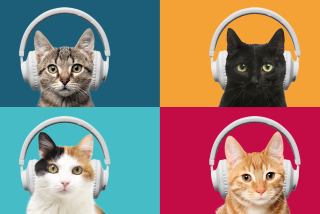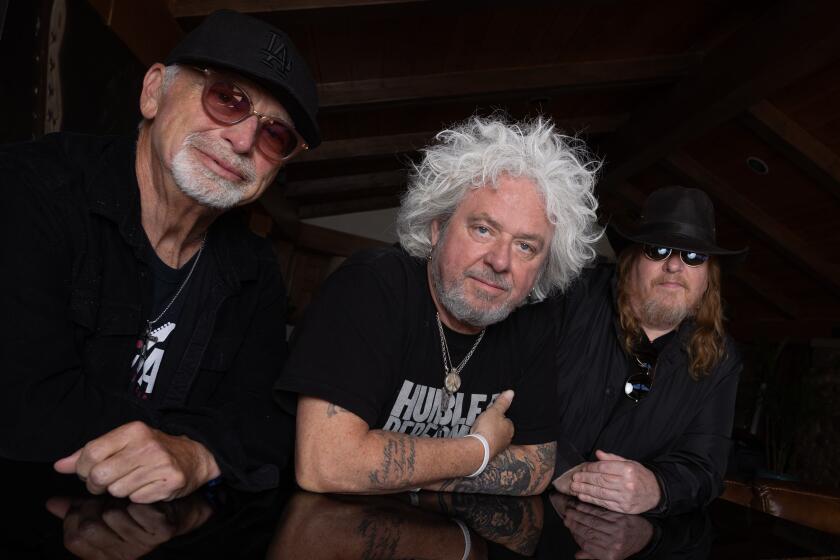After All the Fuss, There’s Free Music at Napster
Napster presents: free music.
No, I’m not stuck back at the turn of the century, when Napster was launched and it became notorious for allowing the world to illegally share music online. That version of the company was shut down in 2002 under the weight of music industry lawsuits.
This week, the revived Napster -- now a fee-based music subscription service -- started to act like it’s 1999, allowing nonmembers to access songs in its 2-million-track catalog for free. Now you can hear a tune as many as five times. For more plays, you have to sign up for a subscription or buy a download of the song.
Rival subscription service Rhapsody has a variation on the free theme, allowing 25 listens a month. You can play the same song 25 times, try 25 songs one time each or enjoy a mix of repeats and solo plays.
Both services allow taste-testing of selections in full. In contrast, online music stores, such as Amazon.com and iTunes, generally offer only 30-second samples of each song.
Assessing before buying is not a new idea -- some CD stores have listening posts where you can don headphones and sample tracks. Before that, large record stores had listening booths where you could play an album to see if it was right for you.
But free music at home? Why, it’s almost like the heyday of Napster.
The free service is fully Web-based (www.napster.com), so there’s no software to download, but you do have to register before listening. And you have to see some on-screen commercials because the service is advertiser-supported.
The service has a search engine in which you can enter the name of an artist, track or album. I first tried a search for the progressive metal band Tool, under artist, and the limitations of this type of service started to become apparent. Napster had nothing by this popular band -- as well as others, including the Beatles -- because those artists or their labels have not agreed to make their songs available.
I ran into a similar obstacle when I typed in “Start of Something,” a song from the “High School Musical” soundtrack album. I could hear only a 30-second snippet of that song but found I could listen to all of “The Start of Something Big” performed by Steve and Eydie.
Things picked up, however. When I searched out Pearl Jam’s recently released self-titled album, I could listen to the complete tracks. Looking for Bob Dylan’s “Tangled Up in Blue,” I found not only his original but also very different renditions by the Indigo Girls and solo artist Mary Lee.
James Carr’s version of the soul standard “The Dark End of the Street” was not available, but Aretha Franklin’s was. And to my surprise, I even found a Bix Beiderbecke/Bing Crosby performance of “There Ain’t No Sweet Man.”
Another advantage of the free service is that you can try different versions of a song by the same artist. There are four renditions, for example, of Kanye West’s “Jesus Walks”: explicit, edited, remix and live.
Classical music was a challenge, as it usually is online. To find a composer’s work, you generally have to search his or her name under artist or album. Then you troll through lists to pinpoint what you want. I was finally able to locate a Glenn Gould performance of a Bach piano concerto, but the three movements were divided into three selections, so I couldn’t listen to them uninterrupted.
Unfortunately, there was no indication of how many times you’ve listened to a selection. Try to exceed your five shots at a track and you get a message saying you have reached your “play limit.”
I have two other quibbles. The free Napster service is extremely slow at the onset -- it sometimes took as long as two minutes to load a song. And the sound quality is at 32 kilobits per second, which is about on par with AM radio. Only if you buy a subscription do you get to hear 128kbps audio.
Rhapsody (www.rhapsody.com) is a smoother, more sophisticated service. It’s been offering songs free of charge for just over a year. The selection is generally the same but the speed and the sound quality, at 128kbps for the free selections, are far superior. An on-screen list shows how much of your monthly 25-song allotment is left.
But I found that my free time on Rhapsody came to an end much faster. I can go through 25 tracks fairly quickly, especially if I am not listening to them all the way through.
I tried out many more songs on Napster, repeatedly playing the ones I loved.
The biggest fault in both services is that you can’t build playlists for future listening.
But they’re free. And addictive, which can lead to another monthly charge in your life -- a subscription to each service costs about $10.
In the meantime, anyone up for three more plays of “Tangled Up in Blue”? This is how I used to lose roommates.
David Colker can be reached via e-mail at technopolis @latimes.com. Previous columns can be found at latimes.com/technopolis.
*
(BEGIN TEXT OF INFOBOX)
Easy listening
The Napster and Rhapsody music services offer nonsubscribers free listens -- with some restrictions -- to millions of tracks in their catalogs.
Napster
* URL: www.napster.com
* Platforms: Mac and Windows
* Free: Five plays of each song
* Pros: Offers the chance to hear a huge number of songs without subscribing
* Cons: Low audio quality, slow processing times, no gauge to show how many times a song has been played
Rhapsody
* URL: www.rhapsody.com
* Platforms: Mac and Windows
* Free: 25 total tracks a month
* Pros: Good sound quality, smooth operation, indicates how many tracks have been played
* Cons: It’s easy to quickly reach the maximum of 25 free plays
Source: Los Angeles Times
More to Read
The biggest entertainment stories
Get our big stories about Hollywood, film, television, music, arts, culture and more right in your inbox as soon as they publish.
You may occasionally receive promotional content from the Los Angeles Times.











